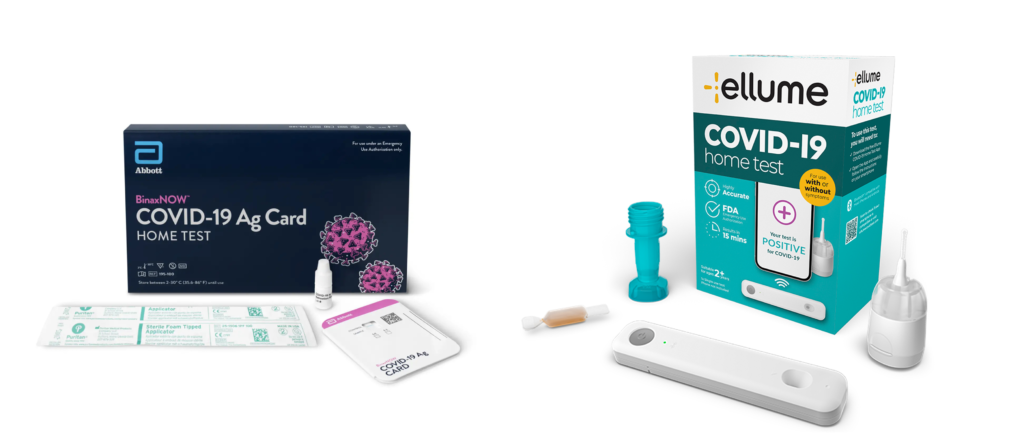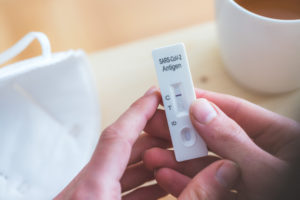In order to return to the United States on an international flight, you’ll have to show proof of a negative COVID-19 test taken no more than three days before you travel (or show documentation of recovery from COVID-19). No one wants to interrupt their vacation to try to find a COVID-19 testing center abroad that will give them acceptable results in time for a flight—fortunately, there are now at-home tests you can buy online and bring with you on an international trip that are valid for re-entry into the U.S. On a recent trip, I tried out two that meet the requirements for international flights. I took Abbott’s BinaxNOW COVID-19 AG At-Home Test Kit through eMed, and my husband took the ellume + Azova COVID-19 test.
Both of these COVID-19 tests were paired with a video observation service, which is required for re-entry to the United States, so make sure you buy the right one. (For example, if you just buy the Ellume test but don’t get the Azova add-on of the video observation, it won’t be valid for an international flight back to the U.S.)

Related: 6 Tips for Getting a COVID-19 Test in Time for Travel
Cost
The ellume + Azova test with video observation cost $50 plus $15 for shipping for one kit, however, they sent me an extra kit for free in the event that the first one didn’t work. If you don’t end up needing the backup test, you can use it for a future trip, but you’ll have to pay an extra $15 for a second video observation appointment.
Abbot’s BinaxNOW test costs $150 plus $15 shipping for a pack of six with video observation through eMed. You are able to designate up to three test-takers who can use the test kits, so you can split the six-pack among your travel party.
Winner: At $27.50 per test (including shipping), Abbot’s BinaxNOW is the cheaper option, especially if you’re traveling with multiple people—however, if you don’t plan to travel again in the future and want to save money upfront, the ellume + Azova is the better deal.
Type of Test
Both tests are rapid antigen tests, self-conducted with a nasal swab.
Winner: Tie.
Shipping Speed
I ordered both tests on the Friday night before the Fourth of July holiday weekend (July 2). The ellume + Azova kit shipped with UPS 2nd Day Air and arrived in the evening on July 8. The eMed order shipped with FedEx Standard Overnight and arrived before noon on July 7.
Winner: eMed.
Related: The 7 Best Face Masks for Travel
Appointments
For the video observation portion, only ellume + Azova required an appointment. Appointments were very easy to get, and when we were delayed by a half-hour past my scheduled time, we were still able to log on and get an observer within a few minutes.
However, I preferred the ease of being able to log on at any time to eMed and take the test at my own convenience rather than being tied to an appointment.
Winner: eMed.
Ease of Use
The eMed test came in a flat box that was very easy to pack, compared to the ellume + Azova which was bulkier.
Both tests required you to download apps to use them—it’s very important that you download these apps before leaving the United States on your trip, as they may not be available to download in the app store outside the country.
You’ll also need to show an identifying document (such as a passport or driver’s license) to your video observer when taking both tests.
The eMed test and video observation was completed online through a web link and also within the NAVICA app. The ellume + Azova test required one app to be downloaded for the test and a second app for the video visit which made things complicated. Since two apps were required, it was easy to start the test without realizing that you hadn’t started the video observation.
To take the test with eMed, you simply follow a link and a video observer walks you through the test process (easy-to-follow instructions are also displayed on screen). The kit included a swab, a test card with QR code, and a processing solution. You scan the QR code on the test card for the video observer. Next, fill the try on the test card with the solution, swab your nose, and insert the swab into the solution. After waiting 15 minutes (during which time the video observer leaves and you can go do other things as well), the video observer has you read your results which are displayed on the test card. The test card shows a control line and a second line will appear if the test is positive.
The ellume + Azova was slightly more tech-savvy. The kit included a swab, a vial, a processing solution, and a test analyzer that connected to the app via Bluetooth. To take the test, you first watch a short video with instructions and then log on to meet with your observer. Next, swab your nose and dip the swab into an included solution, then drip the solution back into the electronic reader where you’ll leave it for 15 minutes to process. When taking the test, the video observer warned us that swabbing the nose insufficiently could result in an “error” message being read by the Bluetooth device. With this test, you're more likely to receive an "error" result than a false negative result if you have the virus and don't swab properly. Likewise, if you don't have the virus, but don't swab well enough, you could still receive an error message and need to take another test.
Winner: eMed.
Results
Both test results were available in the app immediately after the 15-minute test window was up. They each included an easy-to-read document that contained all of the information that the CDC requires for reentry to the United States: Type of test, name of the telehealth service issuing the result, specimen collection date, name of the test-taker plus identifying information (date of birth), and test result.
Winner: Tie.
The Bottom Line
Both tests were used successfully for reentry to the United States. I flew Azores Airlines from the Azores to Boston, and the airline check-in agent reviewed both of our test results pretty thoroughly when checking in. Our tests were not checked upon arriving in Boston, although we were warned by the airline that the customs and border control would be randomly checking tests of arriving passengers.
No matter which test you choose, be sure to pack a second test just in case you receive a false positive or inconclusive result. Consider taking your test as early as possible within the three-day window before your flight. In the (unlikely) event that the test doesn’t work, you’ll hopefully have enough time to find a COVID-19 test at your destination.






